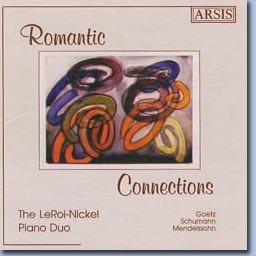Arsis Audio / ce / CD114
Romantic Connections: Timothy & Nancy LeRoi Nickel - Duo Pianists
$15.95
Scroll down for Related Items listings.
The three Romantic composers included on this disc form a natual connection. They represent the mid-century romantic tradition at its finest and most "classical." The energy and formal restraint of Mendelssohn and the dreamy-eyed lyricism of Schumann find their synthesis in the modest but polished works of Hermann Goetz. It is no surprise that the cantankerous old playwright and music critic George Bernard Shaw mentioned the three in the same breath, coming down firmly on the side of the least-known composer. All three were primarily pianists, but also wrote well for chamber ensembles, symphony orchestra, organ, and voice. In the latter category, Mendelssohn was particularly distinguished in oratorio, Schumann in lieder, and Goetz in opera. The three were conservative in approach. They cherished domestic values. They all had extra-musical artistic abilities. They died young. The similarities among the three are striking, especially to the ear. Robert Schumann (1810-1856) had a special love for children. He and his pianist wife Clara raised eight children during the fourteen years of their marriage from 1840 to Schumann's tragic breakdown in 1854. The constant stimulation of a home full of children must have been a source of comfort for Schumann in the midst of frequent frustration in his musical career and depression over his deteriorating mental health. All but one of Schumann's piano works inspired by children date from this period: Album for the Young (1848), Scenes from the Ball (1851) which was originally entitled Children's Ball, the title he then used for his opus 130 (1853), and the three Sonatas for Children, opus 118 (1853). The enormous success of the Album for the Young prompted Schumann's publisher to request a sequal for piano duet the following year, Twelve Four-Hand Piano Pieces for Little and Big Children, opus 85, written in September of 1849 and published in 1850. Actually, the twelve pieces are more similar in mood, texture, and inspiration to Schumann's immortal set of Scenes from Childhood, opus 15 (1835). Of Schumann's five sets of duet works, including his very first piano compositions, Eight Polonaises (1828), these twelve pieces are by far the most refreshing, captivating, and pianistically satisfying. Schumann's musical imagination is remarkably accurate. One can see a room full of children in party hats marching around the glowing candles on a birthday cake. Schumann and his daughter Marie surprised Clara with a first performance of "Birthday March" on September 13, 1849. The "Bear Dance" is a successful elaboration of an unpublished sketch from the Album of the Young. One can imagine a trained bear in irons dancing to the wave of his master's stick in a tiny village square. "Garden Meolody" and "Mourning" are lyrical gems, the latter a brief but perceptive depiction of childhood melancholy. "Circle Dance" brings an image of children in a field of blossoms, pausing, in "Twining Wreaths," to braid colorful crowns of wild flowers, while Schumann weaves 16th notes between primo and secondo pianists. The trumpets and drums of the "Croatian March" and "Tournament March" remind one of another set of twelve piano duets for children, Bizet's Jeux d'Enfants. One could almost be splashed in the face in "By the Fountain," a small-scale Lisztian jeux d'Eau. In "Hide and Seek" and "Ghost Stories," Schumann demonstrates that a little melody, harmony, and rhythm can be worth a thousand pictures. The lovely, concluding "Evening Song" has mesmerized generations of Schumann's enthusiasts. It has surfaced in arrangment for violin, cello, organ, full symphony, and even voice joining Schubet'sMarche Militaire, Brahms' Hungarian Dances and Dvorak's Slavonic Dances as an original piano duet better known in transcription. The great violinist/condcutor Joachim even inserted "Abendlied" in a performance of Brahms' German Requiem when Clara was in attendance. Such dubious laurels are certainly well-earned, the melody is one of the most intoxicately "romantic" tunes Schumann ever wrote. Hermann Goetz was a musical jack-of-all-trades. He was successful composer, operatic producer, orchestra conductor, church organist and choral director, music critic, and distinguished pianist, highly regarded by his mentor, Hans von Bülow. Goetz produced many well-crafted, substantial works in his short creative life, lived under the constant shadow of incurable tuberculosis. His solo piano music enjoyed considerable success,and his two operas, Taming of the Shrew and Francesca von Rimini, have been revived from time to time. It was his Symphony in F that so delighted George Bernard Shaw. Goetz's name appears often in the three volumes of Shaw's published musical criticisms. In his inimitable, opinionated and overstated way, Shaw wrote that "He [Goetz] has the charm of Schubert wtihout his brainlessness, the refinement of Mendelssohn with his limitations and timid gentility, Schumann's sense of harmonic expression without his laboriousness, shortcomings, and dependence on external poetic stimulus; while as to unembarrassed mastery of the materials of music, showing itself in the Mozartean grace and expressiveness of his polyphony, he leaves all three of them simply nowhere. Brahms, who alone touches him in mere brute musical facility, is a dolt in comparison to him." This is quite a vote of confidence from a respected critic of the day who was also a trained musician. The Sonata in G minor, which ranks with the finest of Goetz's chamber music, was written in 1865 but published posthumously in 1878. The quick tempi of the first and last movements are both framed by "langsam" (slow) sections, adding that necessary element of German romantic "Angst." In both cases, however, Goetz breaks away from the return of the slow tempo with an urgent rush to the final bar. The light, nervous 16th-note motion and high energy level remind one of Mendelssohn. The second movement, beautifully crafted for the duet medium, exudes an obvious Schumannesque charm and lyricism. Throughout, the work is classical in form, conservative, and abounding in polished counterpoint. Felix Mendelssohn (1809-1847) wrote his A major Allegro Brillante, opus 92 on March 23, 1841 and performed it in concert eight days later with Clara Schumann, to whom the work is dedicated. The piece has remained popular on the concert stage ever since. It has a distinct scherzo quality, conjuring up the nympths and fairies of A Midsummer Night's Dream. The first theme is always introduced by a rush of ascending scale passages. The second, more lyrical idea appears twice surrounded by bravura passage work and the high spirits of the piece never falter. The writing is gratifying for four hands with varying scale forms and thematic material passed seamlessly between the players to great musical and visual effect. After a brief comic dialogue, the unrelenting energy spills over into a rousing coda marked "presto." -Timothy Nickel Fred Armentrout
Total playing time: 59'42" ROBERT SCHUMANN (1810-1856)
12 vierhändige Klavierstücke für kleine und grosse Kinder. Op 85
12 Four-Hand Piano Pieces for Little and Big Children 1. Geburtstagsmarsch
Birthday March 7. Turniermarsch
Tournament March 2. Bärentanz
Bear Dance 8. Reigen
Round Dance 3. Gartenmelodie
Garden Melody 9. Am Springbrunnen
At the Fountain 4. Beim Kränzewinden
Twining Wreaths 10. Versteckens
Hide and Seek 5. Kroatenmarsch
Croatian March 11. Gespenstermärchen
Ghost Stories 6. Trauer
Mourning 12. Abendlied
Evening Song HERMANN GOETZ (1840-1876)
Sonata in G Minor, Opus 17 13. I. Langsam (Slow) / sehr lebhaft (Very Lively) / sehr langsam (Very Slow) 14. II. Mässig bewegt (Moderately moving) 15. III. Langsam (Slow) / graziös und nicht zu rasch (Gracious and not so fast) FELIX MENDELSSOHN (1809-1847) 16. Allegro Brillante, Opus 92
Recording Engineer: Fred Armentrout, Portland, Oregon
Editing & transfer to digital:
Mastering for CD: Robert Schuneman, ARSIS Audio, Boston, MA
Voicing/Instrument: CD Recording



